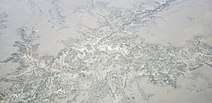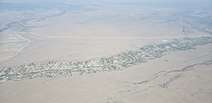Olduvai Gorge
The Olduvai Gorge or Oldupai Gorge in Tanzania is one of the most important paleoanthropological sites in the world; it has proven invaluable in furthering understanding of early human evolution. A steep-sided ravine in the Great Rift Valley that stretches across East Africa, it is about 48 km (30 mi) long, and is located in the eastern Serengeti Plains within the Ngorongoro Conservation Area in the Arusha Region, about 45 kilometres (28 miles) from Laetoli, another important archaeological site of early human occupation. The British/Kenyan paleoanthropologist-archeologist team Mary and Louis Leakey established and developed the excavation and research programs at Olduvai Gorge which achieved great advances of human knowledge and world-renowned status.
| Olduvai Gorge | |
|---|---|
| Oldupai Gorge | |
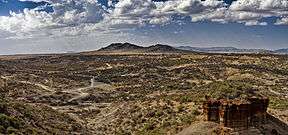 The classic view of Olduvai Gorge with the Naibor Soit hills visible in the distance and a monolith, the so-called "Castle", made of the red sediments of Bed III, in the foreground. | |
 Olduvai Gorge Olduvai Gorge in Tanzania | |
| Length | 48 kilometres (30 mi) |
| Geography | |
| Coordinates | 2°59′37″S 35°21′04″E |
The gorge takes its name from the Maasai word oldupai which means "the place of the wild sisal" as the East African wild sisal (Sansevieria ehrenbergii) grows abundantly throughout the gorge area. Twenty-five kilometers downstream of Lake Ndutu and Lake Masek, the gorge cuts into Pleistocene lake bed sediments up to a depth of 90 m. A side gorge, originating from Lemagrut Mountain, joins the main gorge 8 km from the mouth. This side gorge follows the shoreline of a prehistoric lake, rich in fossils and early man sites. Periodic flows of volcanic ash from Olmoti and Kerimasi helped to ensure preservation of the fossils in the gorge.[1]
The site is significant in showing the increasing developmental and social complexities in the earliest humans, or hominins, largely revealed in the production and use of stone tools. Prior to tools, evidence of scavenging and hunting can be noted—highlighted by the presence of gnaw marks that predate cut marks—and of the ratio of meat versus plant material in the early hominin diet. The collecting of tools and animal remains in a centralised area is evidence of developing social interaction and communal activity. All these factors indicate an increase in cognitive capacities at the beginning of the period of hominids transitioning to hominin—that is, to human—form and behaviour.
Homo habilis, probably the first early human species, occupied Olduvai Gorge approximately 1.9 million years ago (mya); then came a contemporary australopithecine, Paranthropus boisei, 1.8 mya, followed by Homo erectus, 1.2 mya. Our species Homo sapiens, which is estimated to have emerged roughly 300,000 years ago, is dated to have occupied the site 17,000 years ago.
Discovery and research
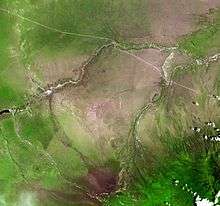
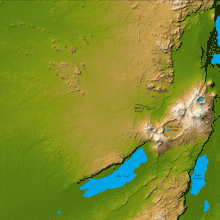
While travelling in German East Africa in 1911 to investigate sleeping sickness,[2] German physician and archaeologist Wilhelm Kattwinkel visited Olduvai Gorge, where he observed many fossil bones of an extinct three-toed horse. Inspired by Kattwinkel's discovery, German geologist Hans Reck led a team to Olduvai in 1913. There, he found hominin remains which were later radiocarbon dated to 17,000 BP. Four more expeditions were planned, but World War I prevented their start. After the war, as Tanzania came under British control, Louis Leakey visited Reck in Berlin and viewed the Olduvai fossils. Louis Leakey became convinced that Olduvai Gorge held stone tools, thinking the deposits were of similar age to the Kariandusi prehistoric site in Kenya. Reck and the paleontologist Donald McInnes accompanied Louis Leakey in his 1931 expedition, where Louis found a number of hand axes close to camp soon after their arrival. Mary Leakey first visited the site in 1935, joining Louis and Percy Edward Kent. Subsequent visits were made by the Leakeys in 1941, 1953, 1955 and 1957.[1]
Louis and Mary Leakey are responsible for most of the excavations and discoveries of the hominin fossils in Olduvai Gorge. In July 1959, at the FLK site (the initials of Louis' first wife Frida Leakey, and K for korongo, the Swahili language word for gully), Mary Leakey found the skull of Zinjanthropus or Australopithecus boisei. In addition to an abundance of faunal remains the Leakeys found stone tools Mary classified as Oldowan. In May 1960, at the FLK North-North site, the Leakeys' son Jonathan found the mandible that proved to be the type specimen for Homo habilis.[1]:17–18,54,56–57,73–77,87
Archaeology and geology
Hans Reck and Richard Hay
While Hans Reck was the first geologist to attempt to understand the geology of the gorge, our current understanding of the geology of the stratigraphic sequence of Olduvai Gorge was made possible in large part by the efforts of geologist Richard Hay. Hay spent twelve years studying the geology at Olduvai, much of it working along with Mary Leakey, finally formulating a detailed picture of the geologic history of the area. Hay's seminal work The Geology of the Olduvai Gorge was published in 1976.[3]
Reck identified five main layers of deposition in the gorge, which were labelled Beds I through V, with Bed I being the oldest and lowest in the sequence. Hay and other geologists working at the gorge since Reck's time have utilized Reck's original Bed outline, adding clarity, detail, and corrections to achieve a more thorough understanding of gorge history. Reck's original Bed IV interval was later distinguished as consisting of Bed IV and the Masek Beds, while Bed V has been reclassified as the Ndutu Bed and the Naisiuiu Bed.7
Gorge Stratigraphy
The stratigraphic sequence in the gorge is up to 90 m thick, with a welded tuff, the Naabi ignimbrite, forming the base. This is overlain by a series of lava flows from Otmoi and from another source to the south. The oldest fossils are found on this surface, dated at 1.89 mya, while stone tools have been dated at 1.7 mya through the first use of K-Ar dating by Garniss Curtis. In addition, fission track dating and paleomagnetism were used to date the deposits, while amino acid dating and Carbon-14 dating were used to date the bones. Hominid fossils and stone tools are found continuously throughout the entire exposed sequence in the gorge. Faulting between 100 and 30 kya, formed the Olbalbal Depression northwest of Ngorongoro.[1]:41–43
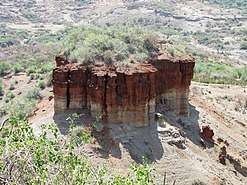
Bed I
The 20–46 m thick Lower Pleistocene Bed I sediments above the basalt consist of layers of Olmoti tuff and lake sediment claystone. Four well-preserved living sites of note are located within Bed I, the FLK and FLK North-North sites mentioned above, plus DK and FLK North. The DK site (Donald McInnes' first initial plus k for korongo) has a stone circle, many tools and fossil bones, and ranges in age from 1.75 mya to 1.9 mya.[1]:45,50–58
Bed II
Bed II consists of 21–35 m of clay and sandstone Olduvai Lake and stream deposits. Manuports are abundant at the MNK (Mark Nicol Korongo) site in addition to a chert nodule quarry containing over 14,000 pieces, including gneiss and lava anvils and hammerstones. Hand axes were found at the EF-HR (Evelyn Fuchs-Hans Reck) and TK (Thiongo Korongo) sites. The BK (Bell's Korongo) site contained an Australopithecus boisei deciduous molar and canine.[1]:58–63
Bed III
The distinctly red Bed III consists of 6–10 m of clays, sandstones and conglomerates signifying intermittent dry lake conditions. Few fossils are present and only isolated stone tools, indicating a sparse early man presence.[1]:63–66
Bed IV
Bed IV is a distinctly different unit from Bed II in the eastern portion of the gorge. There, it is 5–8 m thick and composed of clays, and stream deposited sandstones and conglomerates. Four distinct tool-bearing levels are evident, including 500 handaxes and cleavers at the HK (Hopwood's Korongo) site, while phonolite handaxes and an elephant bone handaxe were found at the HEB (Heberer's Gully) site. The WK (Wayland's Korongo) site contained a Homo erectus pelvis and femur.[1]:66–70
Masek beds
The Masek Beds are composed of two episodes of aeolian ash from Kerimasi. A number of quartzite handaxes were found in this layer at the FLK site. Dunes formed after the deposition of Oldonyo Lengai tuffs make up the uppoer portion of the Ndutu Beds, but yield few fossils. Oldonyo Lengai tuffs also make up the Naisiusiu Beds.[1]:70–72
Associated fossil species
The few Australopithecus boisei remains, which include the skull, a thigh bone fragment, and several teeth, were found distributed throughout Beds I and II, which dates them in the range 1.1 to 2 mya. The more common remains of Homo habilis were found in Bed I and the lower portion of Bed II, which makes them contemporaries of Australopithecus boisei. Homo erectus remains were found in the upper portions of Bed II, making them contemporaries of Australopithecus boisei, but not of Homo habilis.[1]:74
The stone tools and their makers
Louis Leakey first described the Oldowan stone tool industry in 1951. The Leakeys determined that choppers were the most common stone tool found at the site, amounting to over half of the total number, and identified 11 Oldowan sites in the gorge, 9 in Bed I, and 2 in Bed II. They also identified the Developed Oldowan as the subsequent diverse tool-kit found in Beds II, III, and IV, with small tools made mostly from chert rather than quartzite. These tools are mostly spheroids and sub-spheroids, followed by choppers.[1]:88,90,95,98
Besides the chert quarry in Bed II, the Leakeys were able to identify the other source locations of the principal rocks used to make the stone tools. The most common material was quartzite, which originated from the Naibor Soit Inselberg just north of the gorges. The phonolite originated from the Engelosen volcano 5 km to the north. The gneiss came from the Kelogi inselborg 9 km to the southwest.[1]:83–86
The first species found by the Leakeys, Zinjanthropus boisei or Australopithecus boisei (renamed and still debated as Paranthropus boisei), featured a sagittal crest and large molars. These attributes suggested the species engaged in heavy chewing, indicating a diet of tough plant material, including tubers, nuts, and seeds—and possibly large quantities of grasses and sedges.[4]
Conversely, the Leakeys' 1960s finds presented different characteristics. The skull lacked a sagittal crest and the braincase was much more rounded, suggesting it was not australopithecine. The larger braincase suggested a larger brain capacity than that of Australopithecus boisei. These important differences indicated a different species, which eventually was named Homo habilis. Its larger brain capacity and decreased teeth size pointed to Homo as the probable toolmaker.
The oldest tools at Olduvai, found at the lowest layer and classified as Oldowan, consist of pebbles chipped on one edge.[5] Above this layer, and later in time, are the true hand-axe industries, the Chellean and the Acheulean. Higher still (and later still) are located Levallois artifacts, and finally the Stillbay implements.[5] Oldowan tools in general are called "pebble tools" because the blanks chosen by the stone knapper already resembled, in pebble form, the final product.[6] Mary Leakey classified the Oldowan tools according to usage; she developed Oldowan A, B, and C categories, linking them to Modes 1, 2, and 3 assemblages classified according to mode of manufacture. Her work remains a foundation for assessing local, regional, and continental changes in stone tool-making during the early Pleistocene, and aids in assessing which hominins were responsible for the several changes in stone tool technology over time.[7]
It is not known for sure which hominin species was first to create Oldowan tools. The emergence of tool culture has also been associated with the pre-Homo species Australopithecus garhi,[8] and its flourishing is associated with the early species Homo habilis and Homo ergaster. Beginning 1.7 million years ago, early Homo erectus apparently inherited Oldowan technology and refined it into the Acheulean industry.[9]
Oldowan tools occur in Beds I–IV at Olduvai Gorge. Bed I, dated 1.85 to 1.7 mya, contains Oldowan tools and fossils of Paranthropus boisei and Homo habilis, as does Bed II, 1.7 to 1.2 mya. H. habilis gave way to Homo erectus at about 1.6 mya, but P. boisei persisted. Oldowan tools continue to Bed IV at 800,000 to 600,000 before present (BP). A significant change took place between Beds I and II at about 1.5 mya. Flake size increased, the length of bifacial edges (as opposed to single-face edges) occurred more frequently and their length increased, and signs of battering on other artifacts increased. Some likely implications of these factors, among others, are that after this pivotal time hominins used tools more frequently, became better at making tools, and transported tools more often.[10]
Hunters or scavengers?
Though substantial evidence of hunting and scavenging has been discovered at Olduvai Gorge, it is believed by archaeologists that hominins inhabiting the area between 1.9 and 1.7 mya spent the majority of their time gathering wild plant foods, such as berries, tubers and roots. The earliest hominins most likely did not rely on meat for the bulk of their nutrition. Speculation about the amount of meat in their diets is inferred from comparative studies with a close relative of early hominins: the modern chimpanzee. The chimpanzee's diet in the wild consists of only about five percent as meat. And the diets of modern hunter-gatherers do not include a large amount of meat. That is, most of the calories in both groups' diets came from plant sources. Thus, it can be assumed that early hominins had similar diet proportions, (see the middle-range theory or bridging arguments—bridging arguments are used by archaeologists to explain past behaviors, and they include an underlying assumption of uniformitarianism.)
Much of the information about early hominins comes from tools and debris piles of lithic flakes from such sites as FLK-Zinjanthropus in Olduvai Gorge. Early hominins selected specific types of rocks that would break in a predictable manner when "worked", and carried these rocks from deposits several kilometres away. Archaeologists such as Fiona Marshall fitted rock fragments back together like a puzzle. She states in her article "Life in Olduvai Gorge" that early hominins, "knew the right angle to hit the cobble, or core, in order to successfully produce sharp-edged flakes ...". She noted that selected flakes then were used to cut meat from animal carcasses, and shaped cobbles (called choppers) were used to extract marrow and to chop tough plant material.
Bone fragments of birds, fish, amphibians, and large mammals were found at the FLK-Zinj site, many of which were scarred with marks. These likely were made by hominins breaking open the bones for marrow, using tools to strip the meat, or by carnivores having gnawed the bones. Since several kinds of marks are present together, some archaeologists including Lewis Binford think that hominins scavenged the meat or marrow left over from carnivore kills. Others like Henry Bunn believe the hominins hunted and killed these animals, and carnivores later chewed the bones.[11] This issue is still debated today, but archaeologist Pat Shipman provided evidence that scavenging was probably the more common practice; she published that the majority of carnivore teeth marks came before the cut marks. Another finding by Shipman at FLK-Zinj is that many of the wildebeest bones found there are over-represented by adult and male bones; and this may indicate that hominins were systematically hunting these animals as well as scavenging them. The issue of hunting versus gathering at Olduvai Gorge is still a controversial one.[12]
Hominid fossils found at Olduvai Gorge

- Olduvai Hominid 5
- Olduvai Hominid 7
- Olduvai Hominid 8
- Olduvai Hominid 9
- Olduvai Hominid 24
- Olduvai Hominid 62
Olduvai Gorge monument and museum
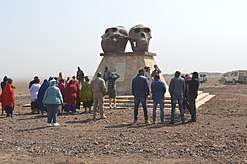
In July of 2019, the Olduvai Gorge Monument was erected at the turnoff to Olduvai Gorge from the road which connects Ngorongoro Conservation Area and Serengeti National Park (a route traveled by safari-goers). The monument was designed and planned by paleoanthropologists Nicholas Toth, Kathy Schick, and Jackson Njau at the invitation of the Tanzanian government in order to celebrate this important site and to attract visitors to the gorge and its new museum. The monument consists of two large-scale models of fossil skulls which sit atop a large pedestal with an informative plaque mounted on the side of the pedestal. The fossil skulls depicted are Paranthropus boisei and Homo habilis, two contemporary species which were first discovered at Olduvai Gorge. Schick, Toth, Njau and Joshua Mwankunda (NCAA Cultural Heritage Manager) commissioned the celebrated Tanzanian artist Festo Kijo to create the two large concrete skulls which he modeled using life-size fossil casts provided by the researchers. The large-scale models created by Kijo are each 6 feet tall and weigh 5,000 pounds. The monument project was funded by the Stone Age Institute and the John Templeton Foundation, in partnership with the Ngorongoro Conservation Area Authority (NCAA).[13][14]
The Olduvai Gorge Museum, located 5 km beyond the monument, is situated on the rim of the gorge at the junction of the main gorge and the side gorge. As one of the largest onsite museum in Africa, the museum provides educational exhibits related to the gorge and its long history.
Gallery
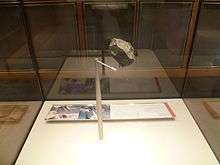 The oldest human-made object in the British Museum[15]
The oldest human-made object in the British Museum[15]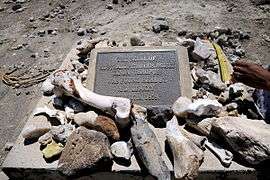 The spot where the first P. boisei was discovered in Tanzania
The spot where the first P. boisei was discovered in Tanzania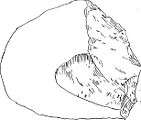 Oldowan stone chopper
Oldowan stone chopper- About 1.8 million years old
See also
References
- Leakey, Mary (1979). Olduvai Gorge. London: Book Club Associates. pp. 11–17, 40.
- Maier, Gerhard, African Dinosaurs Unearthed: The Tendaguru Expeditions, Indiana University Press, 2003, ISBN 978-0253342140
- Hay, Richard L. (Richard LeRoy), 1926- (1976). Geology of the Olduvai Gorge : a study of sedimentation in a semiarid basin. Berkeley: University of California Press. ISBN 0-520-02963-1. OCLC 2391581.CS1 maint: multiple names: authors list (link)
- Macho, Gabriele A. (2014). "Baboon Feeding Ecology Informs the Dietary Niche of Paranthropus boisei". PLOS ONE. 9 (1): 84942. Bibcode:2014PLoSO...984942M. doi:10.1371/journal.pone.0084942. PMC 3885648. PMID 24416315.
- Langer, William L., ed. (1972). An Encyclopedia of World History (5th ed.). Boston, MA: Houghton Mifflin Company. pp. 9. ISBN 978-0-395-13592-1.
- Napier, John. 1960. "Fossil Hand Bones from Olduvai Gorge." in Nature", December 17th edition.
- Barham, Lawrence; Mitchell, Peter (2008). The First Aftricans. Cambridge University Press. p. 126.
- De Heinzelin, J; Clark, JD; White, T; Hart, W; Renne, P; Woldegabriel, G; Beyene, Y; Vrba, E (1999). "Environment and behavior of 2.5-million-year-old Bouri hominids". Science. 284 (5414): 625–9. Bibcode:1999Sci...284..625D. doi:10.1126/science.284.5414.625. PMID 10213682.
- Richards, M.P. (December 2002). "A brief review of the archaeological evidence for Palaeolithic and Neolithic subsistence". European Journal of Clinical Nutrition. 56 (12): 1270–1278. doi:10.1038/sj.ejcn.1601646. PMID 12494313. .
- Kimura, Yuki. C (2002). Examining time trends in the Oldowan technology at Beds I and II, Olduvai Gorge. 43. Journal of Human Evolution. PMID 12234546.
- Bunn, Henry (2007). Peter Ungar (ed.). Meat Made Us Human. New York: Oxford University Press. pp. 191–211. ISBN 978-0195183467.
- Ungar, Peter (2007). Peter Ungar (ed.). Evolution of the Human Diet. New York: Oxford University Press. ISBN 978-0195183467.
- Jan 3; Science, 2020 |; Education. "Stone Age Institute Designs Monument at Olduvai Gorge | Bloom Magazine". Retrieved 2020-01-23.CS1 maint: numeric names: authors list (link)
- "Zinj Tower launch: Jubilant PM sees all humans as Tanzanians". www.ippmedia.com. Retrieved 2020-01-23.
- "A History of the World in 100 Objects". The British Museum. Retrieved 18 May 2016.
Further reading
- Cole, Sonia (1975). Leakey's Luck. Harcourt Brace Jovanvich, New York.
- Colin Renfrew and Paul Bahn Archaeology Essentials (2007). Archaeology Essentials. 2nd Edition. Thames & Hudson Ltd, London.
- Deocampo, Daniel M (2004). "Authigenic clays in East Africa: Regional trends and paleolimnology at the Plio-Pleistocene boundary, Olduvai Gorge, Tanzania". Journal of Paleolimnology. 31: 1–9. doi:10.1023/b:jopl.0000013353.86120.9b.
- Deocampo, Daniel M.; Blumenschine, R.J.; Ashley, G.M. (2002). "Freshwater wetland diagenesis and traces of early hominids in the lowermost Bed II (~1.8 myr) playa lake-margin at Olduvai Gorge, Tanzania". Quaternary Research. 57: 271–281. doi:10.1006/qres.2001.2317.
- Hay, Richard L. (1976). "Geology of the Olduvai Gorge." University of California Press, 203 pp.
- Gengo, Michael F. (2009). Evidence of Human Evolution, Interpreting. Encyclopedia of Time: Science, Philosophy, Theology, & Culture.SAGE Publications. 5 Dec. 2011.
- Young, Lisa (2 October 2011). Hominin Migrations Out of Africa. Introduction to Prehistoric Archaeology. University of Michigan.
- Tactikos, Joanne Christine (2006). A landscape perspective on the Oldowan from Olduvai Gorge, Tanzania. ISBN 0-542-15698-9.
- Leakey, L.S.B. (1974). By the evidence: Memoirs 1932-1951. Harcourt Brace Jovanavich, New York, ISBN 0-15-149454-1.
- Leakey, M.D. (1971). Olduvai Gorge: Excavations in beds I & II 1960–1963. Cambridge University Press, Cambridge.
- Leakey, M.D. (1984). Disclosing the past. Doubleday & Co., New York, ISBN 0-385-18961-3.
- Marshall, Fiona. (1999). Life in OLDUVAI GORGE. Calliope Sept. 1999: 16. General OneFile. Web. 4 Dec. 2011.
- Young, Lisa (25 September 2011). The First Stone Tool Makers. Introduction to Prehistoric Archaeology. University of Michigan.
External links
| Wikimedia Commons has media related to Olduvai Gorge. |
